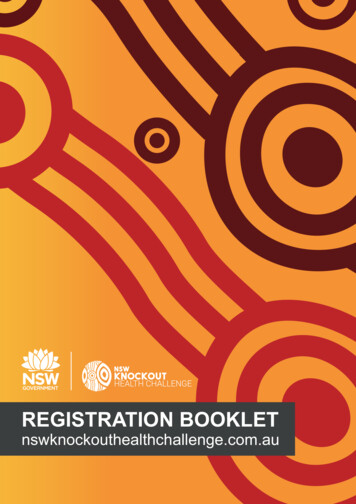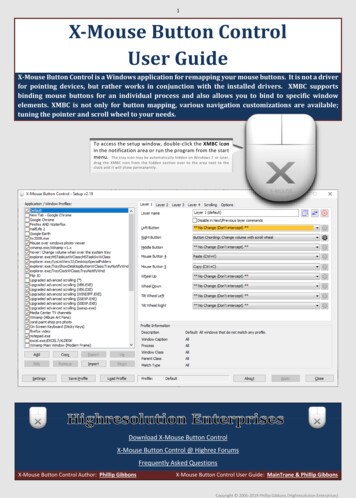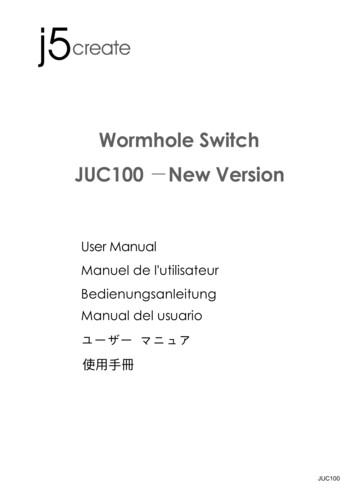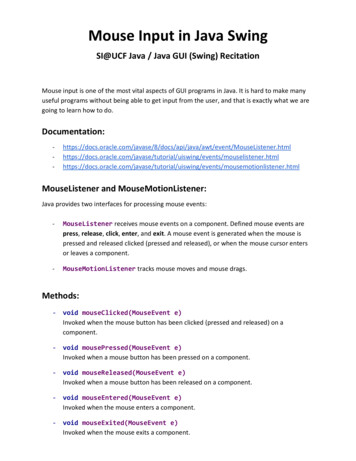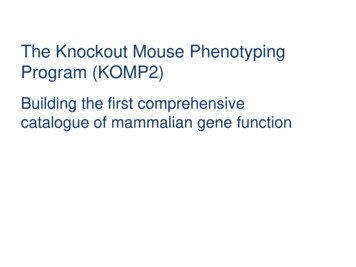
Transcription
The Knockout Mouse PhenotypingProgram (KOMP2)Building the first comprehensivecatalogue of mammalian gene function
The context and challenge Much of the mammalian genome is “dark”** - thefunction of the majority of genes in the mouse andhuman genomes is unknown The functional consequences of human genetic variationare poorly understood The functional analysis of the various elements of thenon-coding genome has been limited The number of variants of unknown significance isincreasing rapidly, but is not met by a commensurateanalysis of function The mouse is critical to dissect and understand theimportance of genetic variation**Oprea et al. and IDG, Nature Reviews Drug Discovery, Unexplored therapeutic opportunitiesIn the human genome, May 2018.
Knockout Mouse Phenotyping Program (KOMP2) Standardization Reproducibility Uniform C57BL/6N geneticbackground Defined, validated alleles Standardized phenotypingprotocols Rapid data release Throughwww.mousephenotype.org Open availability of resourcesGoal:completion ofthe genomeInternational PartnersPhase 1(2011-2016)Generate andPhenotype 2500KO linesPhase 2(2016-2021)Generate andPhenotype 3000KO lines
www.mousephenotype.org
KOMP2/IMPC Goals and Impact Generate a mouse null mutant for every protein-codinggene in the mouse genome Comprehensively phenotype each mouse mutant todetermine developmental, physiological, and biochemicalparameters Provide an important baseline for exploring gene function Develop a more profound understanding of the genomelandscape and genetic mechanisms Enhance the interpretation of human genetic data, fromrare to complex diseases, and the analysis of largepopulation datasets The functional annotation of human genetic variation
Evolution and ImpactNature, 2016Nature Genetics, 2017Nature Comms, 2017Nature Comms, 2017Nature Comms, 2018
Program Update 12,391 microinjections 7,548 genotype confirmedlines ( 2000 CRISPR) 5,870 lines phenotyped Data Release (8.0) for5,505 lines 61.7 million data points Approx. 369k images
Knockout allelesPhase 1: IKMC ES cell resources”KO first,conditional-ready”VelocigenePhase 2: CRISPR-mediatedexon deletion
Phenotyping examines multiple systemsOpen Field with Light/Dark ChallengeModified SHIRPA/DysmorphologyNeurological/BehaviourAuditory Brain Stem ResponseSensorySlit Lamp/OphthalmoscopeGrip StrengthEye morphologyAcoustic Startle/PPIElectroretinographyFear conditioningMusculoskeletalWeightGrip StrengthBody Composition (DEXA)Whole body X-rayCalorimetryMetabolismIntraperitoneal Glucose Tolerance TestImmunologyBody Composition (DEXA)HematologyFACS analysis – blood/spleenClinical Blood ChemistryModified SHIRPA/DysmorphologyCardiovascularReproductionECG / EchoHeart WeightFertilityGross Pathology & Tissue CollectionGeneralTissue embedding & Block BankingHistopathology
Standardized AdultPhenotyping Pipeline(7 males and 7 females)
High hit rate, Extensive pleiotropy IMPC data: Of 3,513 gene KOs with sufficient phenotyping complete*, 2,929 (83.7)%show at least one phenotype. MGI data: Of 9,351** gene KOs, 8,389 (89.7%) report at least on phenotype.* 13 Phenotyping parameters complete** Includes some, but not all, IMPC data700600Gene Counts5004003002001000012345678910 11 12 13 14 15 16 17 18 19 20 21 22 23 24 24 24 25 26Number of Phenotypes
Hit rate varies by system% associated genes with 13 procedures donemuscle phenotypeliver/biliary system phenotypedigestive/alimentary phenotyperespiratory system phenotypepigmentation phenotypecraniofacial phenotyperenal/urinary system phenotypehearing/vestibular/ear phenotypeendocrine/exocrine gland phenotypelimbs/digits/tail phenotypeembryo phenotypenervous system phenotypeintegument phenotypeadipose tissue phenotypereproductive system phenotypevision/eye phenotypeimmune system phenotypegrowth/size/body region phenotypecardiovascular system phenotypeskeleton phenotypehematopoietic system phenotypebehavior/neurological phenotypehomeostasis/metabolism 0%25.00%30.00%35.00%38% of all KO alleles show partial or complete embryonic lethality40.00%
KOMP2: Embryonic LethalityViability screen andcohort productionAlternate SubviablePipeline5311,0220% Hom2,5230 Hom 12.5%EmbryonicPhenotyping PipelineChih-We Hsu, Ph.D.Mary Dickinson, Ph.D
Embryonic Phenotyping PipelineLethal and subviablePattern formation (E9.5)Mid-gestation (E12.5)Organogenesis(E14.5/15.5)Perinatal (E18.5/P0)Genotype ratiosGenotype ratiosGenotype ratiosGenotype ratiosGross MorphologyGross MorphologyGross MorphologyGross MorphologyChih-We Hsu, Ph.D.Mary Dickinson, Ph.D.
Automated analysis pipeline for discovery ofembryonic phenotypesMichael Wong, Mark Henkelman
IMPC web portalwww.mousephenotype.org
IMPC website – phenotypes
Significantannotations in anumber of parameters
Obtain Mouse Lines and Reagents
Building partnerships to maximize impactKOMP2 Centers for Mendelian GenomicsGabriella Miller Kids FirstBaylor College of Medicine Undiagnosed Disease NetworkBaylor GeneticsThe Jackson Laboratory Center for System Neurogenetics of AddictionMODEL-ADMRC Harwell Institute, UK Genomics England (sequencing 100k genomes)Genome Editing Mice in Medicine fundingUK Dementia Research InstituteThe Centre for Phenogenomics, Toronto Care4RareProvince of Ontario Neurodevelopmental Disorders (POND)ConsortiumThe UC Davis Mouse BiologyProgram Center for In Vivo Characterization of ENCODE Elements (CIViC)Undiagnosed Disease Network
Opportunities for collaboration Null alleles for genes discovered in Kids First program Genes with clear mouse orthologue Novel gene knockouts prioritized (no existing knockout) Report back on existing IMPC models, assignments, and knockouts in progress Modeling of precision variants Develop framework for nominating clinically relevant disease variants formodeling Define reporting milestones and timelines; develop useful reporting tools Receive nominations for specific disease variants from Kids First team forproduction Discuss potential custom phenotyping packages suited for disease of interest Establish guidelines for data sharing and publication
Canadian Institutes of Health Research
Kids First-KOMP2 collaboration:Precision Modeling of Pediatric ConditionsSeptember 21, 2018Knockout Mouse Phenotyping Project (KOMP2)
Today’s Webinar1) International Mouse Phenotyping Consortium(IMPC)/Knockout Mouse Phenotyping (KOMP2):–KOMP2 background and goals of this collaboration–Presented by Steve Murray, PhD, The Jackson Laboratory2) Gabriella Miller Kids First Pediatric ResearchProgram (Kids First):–How to nominate variants for this opportunity–Presented by James Coulombe, PhD, NICHD, NIH3) Questions2
Brief Kids First Program Update
VisionAlleviate suffering from childhood cancerand structural birth defects by fosteringcollaborative research to uncover theetiology of these diseases and supportingdata sharing within the pediatric researchcommunity.4
Kids First Data Resource Portal is live!Available datasets: :– Congenital Diaphragmatic Hernia (FY15) –phs001110– Orofacial Cleft Birth Defects (FY15) – phs001168– Ewing sarcoma (FY15) – phs001228– Structural Heart Defects/PCGC (FY15) –phs001138– Congenital Cranial Dysinnervation Disorders –phs0012475
Sept 26: Kids First Data Resource Center (DRC) & Portal WebinarThe Kids First DRC will share progress in their missionto accelerate discoveries for childhood cancer andbirth defect communities, including a demonstrationof the new Kids First Data Resource Portal.Date: Wednesday, September 26, 2018Time: 10:00 AM – 5:00 PM EDTLocation: WebEx onlyRegister at ce-center-webinar-tickets-49098180981The webinar will cover: Overview of the Kids First Program and DataResource Center progress Update on the DRC’s engagements with patientsand foundations Live demonstration of the Data Resource Portal Currently available datasets and how to accessKids First data Questions from the Kids First Community
Kids First X01 Cohorts (Years 1-3)Adolescent Idiopathic Scoliosis (FY16)Cancer Susceptibility (FY16)Congenital Diaphragmatic Hernia (FY15, 16, 17)Craniofacial Microsomia (FY17)Disorders of Sex Development (FY15) 18,000 genomesEnchondromatoses (FY17) 6,000 casesEwing Sarcoma (FY15, 17)Familial Leukemia (FY16)Hearing Loss (FY16)Infantile Hemangiomas (FY17)Neuroblastomas (FY16)Nonsyndromic Craniosynostosis (FY17)Orofacial Clefts; Caucasian (FY15), Latin American (FY16), Asian & African (FY17)Osteosarcoma (FY15)Patients with both childhood cancer and birth defects (FY17)Structural Heart & Other Defects (FY15, 16)Syndromic Cranial Dysinnervation Disorders (FY15)Blue Released Datasets
2018 X01 Cohorts (Year 4)BEEC (Bladder extrophy, Epispadias, Complex)Congenital Heart Defects and Acute Lymphoblastic Leukemiain Children with Down Syndrome** 8,000 genomesCongenital Heart DiseaseCornelia de Lange SyndromeEsophageal Atresia and Tracheoesophageal FistulasFetal Alcohol Spectrum Disorders*Intracranial Germ Cell TumorsKidney and Urinary Tract DefectsMicrotiaMyeloid Malignancies overlap with Down syndrome**Vascular Anomalies, Overgrowth
How to Nominate Variants
GoalDevelop mouse strains to study, phenotype, andvalidate coding and noncoding genetic variantsidentified from Kids First whole genome datasets. Youare invited to nominate variants identified through youranalysis of Kids First datasets for mouse modelproduction and phenotyping.
EvaluationsNominations will be reviewed administrativelyby a subcommittee of NIH staff from the KidsFirst Working Group and variants will beprioritized based on the strength and breadth ofthe supporting evidence. Decisions will befinalized in consultation with KOMP2 staff.
Variant JustificationIn no more than three pages per nominated variant, please address the following:1.2.3.4.5.6.Kids First data sets usedVariant(s) you are proposing to model and mouse ortholog (ifknown)Phenotype of the human case(s) associated with the variant.The predicted mouse phenotype associated with the variant andthe predicted value of the data for your study (e.g. pathogenicityconfirmation, further mechanistic study, etc.)Supporting evidence that this variant is associated with thisphenotype. Summarize findings from bioinformatic analyses,literature review, and entries in relevant databases, includingexisting animal models (e.g. IMPC, MGI, Zfin, Xenbase).Provide any additional justification that should be considered.
Nulls Null variants will be considered as part ofKOMP2’s existing/standard pipeline andprocess For questions related this Kids Firstcollaboration or KOMP’s pipeline fornull/knockout models, contact:KidsFirstKOMP@nih.gov.
Deadline Please submit variant nominations by emailto valerie.cotton@nih.gov by COB October26, 2018. Additional information may be requested afterpreliminary review.
Other Model Organisms? The program intends to use this process tospur other opportunities within NIH.
Questions? For technical questions or additionalinformation about this variant productionpipeline contact: KidsFirstKOMP@nih.gov(this email connects to KOMP2 staff)
Questions? Un-mute yourself by selecting *6 on yourtelephone or clicking on the mic symbol under“Audio Connection”,or Message us via the WebEx chat function17
Upcoming Events
Sept 26: Kids First Data Resource Center (DRC) & Portal WebinarThe Kids First DRC will share progress in their missionto accelerate discoveries for childhood cancer andbirth defect communities, including a demonstrationof the new Kids First Data Resource Portal.Date: Wednesday, September 26, 2018Time: 10:00 AM – 5:00 PM EDTLocation: WebEx onlyRegister at ce-center-webinar-tickets-49098180981The webinar will cover: Overview of the Kids First Program and DataResource Center progress Update on the DRC’s engagements with patientsand foundations Live demonstration of the Data Resource Portal Currently available datasets and how to accessKids First data Questions from the Kids First Community
Oct 2: KOMP2/IMPC “Collaboration Day”You’re invited to join the KOMP2/IMPC Annual Meeting on Tuesday, October 2nd. Thisone day meeting will be focused on collaborations with various human disease genediscovery programs. The day will feature talks and discussions from current andpotential collaborators, specifically groups focused on human genes and variants whomay find KOMP data helpful for their efforts. These include the Centers for MendelianGenetics (CMG), Trans-Omics for Precision Medicine (TopMed), Gabriella Miller KidsFirst Pediatric Research Program (Kids First), and Undiagnosed Disease Network(UDN).Please feel free to view the live webcast at https://www.genome.gov/27572031.”Knockout Mouse Phenotyping Project (KOMP2)20
Oct 18: Kids First Poster Session and Meet & Greet at the AmericanSociety of Human Genetics (ASHG) Annual MeetingThis evening poster session will focus on analyses of Kids First cohorts, and existing collaborativeefforts across Kids First projects. The poster session is an opportunity for the scientificcommunity, and public to engage with Kids First investigators, Data Resource Center staff,collaborators and Kids First leadership. Attendees will gain a broad understanding of the utility ofgenomic data generated by Kids First, and how researchers can use Kids First data to accelerateresearch and promote new discoveries.Date: Thursday, October 18, 2018Time: 7:00pm-10:00pm PDTLocation: Marriott Marquis San Diego Marina333 West Harbor DriveSan Diego, CA 92101Register at -session-and-meet-greet-at-ashgtickets-48285354796
Thank You!Email Additional Questions to:KidsFirstKOMP@nih.gov.
vision/eye phenotype. reproductive system phenotype. adipose tissue phenotype. integument phenotype. nervous system phenotype. embryo phenotype. limbs/digits/tail phenotype. endocrine/exocrine gland phenotype. hearing/vestibular/ear phenotype. renal/urinary system phenotype. craniofacial phenotype. pigmentation phenotype. respiratory system .





